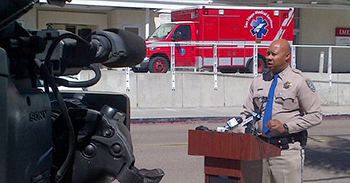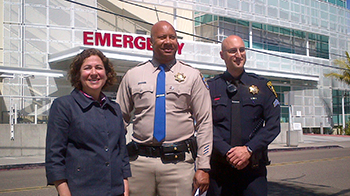
By:
- Kim Edwards
Published Date
By:
- Kim Edwards
Share This:
Distracted Driving is New DUI for College Students in San Diego

Capt. Rich Stewart, commander of the San Diego Region of the California Highway Patrol, discusses the dangers of distracted driving.
Fifty percent of San Diego area college students admitted to sending text messages while driving on the freeway, according to a study released Tuesday from UC San Diego's Trauma Epidemiology and Injury Prevention Research Center. The study analyzed the driving habits of nearly 5,000 students from nine San Diego area colleges, including UC San Diego, San Diego State University, and the University of San Diego.
Nearly 80 percent of those surveyed admitted to talking or texting on a cell phone while driving, according to the study conducted by the center’s Training Research and Education for Driving Safety (TREDS.)
“We can’t wait another generation to correct this problem,” said lead investigator Dr. Linda Hill, a clinical professor in the department of family and preventive medicine at the UC San Diego School of Medicine. “Despite the known dangers, distracted driving has become an accepted behavior. We must spread the word that no one has the ability to multitask and safely drive, no matter how capable you think you are.”
Distracted Driving Behaviors Reported by Surveyed College Students
- 50 percent text while driving on freeway
- 78 percent drive while using a cell phone (talking or texting)
- 87 percent text while at traffic lights
- 60 percent text while in stop and go traffic or driving on city streets
- 52 percent use hands-free devices at least some of the time
- Only 12 percent said they never text, not even at a traffic light
Distracted driving occurs when the driver has their eyes, ears, hands or attention away from the road. Distractions include cell phones, radios, GPS devices, passengers, computers, and other items, such as food.
“Our best estimates show that talking on a cell phone while driving increases the crash risk two to four times, with no difference between hands-free and hand-held devices,” said Hill. “Texting is estimated to increase the risk up to 16 fold, which is four times worse than driving under the influence of alcohol!”
Ten states have banned hand-held cell phones, including California. California has also banned texting, any phone use for novice drivers, and any phone use for school bus drivers.
Capt. Rich Stewart, commander of the San Diego Region of the California Highway Patrol, backed up Hill’s survey results with experience. “Distracted driving is the No. 1 cause of teen accidents and fatalities,” he said. “Often, when our officers regard a vehicle weaving, driving too fast or slowing down, we think it’s possibly a driver under the influence. Quite often it’s someone who’s texting.”
In Hill’s anonymous Internet survey, the average student was 21 years old; 66 percent of those surveyed were female; 83 percent were undergraduates; and 17 percent graduate students. Most students considered driving and talking or driving and texting “the norm,” and most had an inflated opinion of their ability to do so. Forty-six percent of the respondents thought that they were safe to drive distracted, but said only nine percent of their peers were able to do so.

From left, Dr. Linda Hill, Capt. Rich Stewart and Detective Brian MacPherson
“It’s a generational thing,” said UC San Diego Police Detective Brian MacPherson. “These kids are used to wearing earphones and texting while talking and walking or listening to music, and they don’t stop these multitasking behaviors when they get in the car.”
Hill’s survey provides a glimmer of hope in that it suggests that public awareness could change this trend, just as previous public health and safety campaigns changed attitudes towards wearing seatbelts. When asked to identify hypothetical scenarios that would influence their behavior, those surveyed said they might be deterred from picking up the phone if insurance companies wouldn’t cover crashes related to distracted driving, if a citation resulted in a point on their driving record, or if a first-time fine were at least $350.
“We all need to understand that distracted driving is dangerous in any form, no matter what the penalty,” added Hill. “Drivers’ lives and their potential crash victim’s lives are at stake. Our ‘instant communication’ M.O. is addicting, so if you can’t resist answering, lock your phone in the trunk to remove the temptation; it’s not worth the risk.”
To read more information about the survey, please visit http://treds.ucsd.edu/?p=1038
Share This:
You May Also Like
Stay in the Know
Keep up with all the latest from UC San Diego. Subscribe to the newsletter today.


